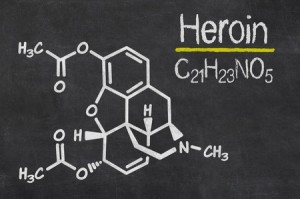Fake Heroin and Homemade Opioids

Okay, now there is a “fake” heroin on the market. What’s going on in the drug trade? There seems to be wanna-be “Walter White” biochemists trying to tweak opioid molecules for a bigger-and-better high. On July 17, 2015, the DEA issued a final order to temporarily schedule acetyl fentanyl into Schedule 1. This was said to be “necessary to avoid an imminent hazard to the public safety.” Before the action by the DEA, the drug was illicit, but still technically legal as long as it had a label that read “Not for human consumption.”
Paul Gaia, writing for The Fix, said acetyl fentanyl was first identified in 2013. A small amount can produce a euphoria like heroin or oxycodone. Because of the similar euphoria, acetyl fentanyl can be sold as heroin or mixed with heroin or oxycodone to produce a stronger high. Regularly buyers are unaware of the mixture or the added danger it brings. Acetyl fentanyl is said to be 5 to 15 times more potent than heroin. It has resulted in a series of ER visits and at least 39 overdose deaths.
Reporting for Vice News, Tessa Stuart said a Montreal supplier of acetyl fentanyl was busted with three kilograms. “Given that a typical dose of acetyl fentanyl is in the microgram range, a three-kilogram quantity could potentially produce millions of dosage units.” Because of its strength, it requires a larger dose of naloxone, perhaps double, to counteract overdoses. Its greater potency also means the difference between a recreational dose and a lethal dose of acetyl fentanyl is much smaller, leading to the increase in overdoses among individuals who are unaware they are not shooting pure heroin.
An editorial published in 2014, “The Potential Threat of Acetyl Fentanyl,” said that because it is an analogue of fentanyl, before the DEA action, drug distribution networks faced less severe legal penalties from cutting or replacing drugs like heroin or oxycodone with acetyl fentanyl. This legal grey area meant that as long as it was unregulated, there was a clear motivation for distribution networks to replace or mix heroin with it. Pressed into a pill form, acetyl fentanyl can be peddled as oxycodone. The author recommended the elimination of the loophole for products containing an analogue of a controlled substance when it is labeled “not for human consumption.”
Analogues regulated in this way present a challenge for law enforcement and prosecutors because products that are clearly intended for recreational use sidestep regulations of their marketed purpose is something else.
Fentanyl-laced heroin is not new. The CDC warned in a “Morbidity and Mortality Weekly Report” that 10 overdose deaths in Rhode Island in March-May of 2013 were from acetyl fentanyl. On June 27, 2013, the State of Pennsylvania Department of Drug and Alcohol Programs published a bulletin, “News for Immediate Release,” which noted that there were at least 50 confirmed fatalities and five non-fatal overdoses that year from fentanyl or acetyl fentanyl. The “Theraflu” overdose epidemic in the Pittsburgh area in January of 2014 seems to have been acetyl fentanyl-laced heroin.
Fentanyl-related deaths are also going global. Both The Fix and Vice News reported a 25% rise in overdose deaths attributed to fentanyl in British Columbia (BC) over the past three years. A Vice reference to a pill form known as “fake oxy” suggests that what is being sold is acetyl fentanyl. A survey by the BC Center for Disease Control found that 29% of drug users in the province had fentanyl in their system.
And the problem isn’t limited to BC, with a growing number of similar deaths happening across the country. In 2014, fentanyl was a factor in the deaths of 120 people in Alberta, and there have been 50 such deaths already this year. In Ontario, the drug is killing twice as many people as heroin. Across North American, fentanyl is rapidly becoming a drug of choice for many users.
Reporting for The Fix, Paul Gaia said that fentanyl has been a problem in countries such as Russia, the Ukraine and Sweden. Manufacturing labs have been seized in Mexico, Germany, Japan and China. A gas used in the 2002 assault on a Moscow theatre was based on fentanyl. A report from the European Monitoring Centre for Drugs and Drug Addiction, “Fentanyl in Europe” indicated there were an estimated 650 deaths in Estonia due to fentanyl between 2005 and 2011. Almost all the cases were IV drug users of illicitly produced fentanyl.
Not only is there fake heroin, there is the potential to produce a variety of different opiates from yeast. Lexi Pandell, reported for Wired how Stanford researchers have developed a method for replicating the poppy’s opiate-producing chemical pathways by genetically modifying yeast. John Duber, a bioengineer at UC Berkley said that you would need a background in synthetic biology and genetics to produce the right kind of yeast, so it’s not an imminent threat. “But if a strain made for licit purposes got out, then all that would be required is knowledge of brewing beer to ferment it into morphine.” Here is a link to the abstract of their article published in Science.
Dueber said that at this point, “the illicit danger is concrete.” But he also thinks the potential benefits are immense. He suggested that scientists and policymakers start now to consider the possibilities before the science gets ahead of the regulations—like what happened with acetyl fentanyl. Kenneth Oye, an MIT professor, suggested that developers could make yeast less appealing for illegal use by generating yeast strains that produce less-addictive drugs. Or they could make finicky strains that are hard to maintain outside of a lab. Oye also said regulators could require the yeast DNA be “watermarked,” so it could be traced back to specific labs.
In a May 2015 commentary published in Nature, Oye also said:
The synthetic-biology community, in tandem with regulators, needs to be proactive in evaluating the costs and benefits of such dual-use technologies. Here we lay out the priorities for discussions that are crucial to public health and safety, and to the progress of synthetic biology more broadly. These include restricting engineered yeast strains to licensed facilities and authorized researchers and technicians; reducing the attractiveness of engineered yeast strains in the illicit marketplace; and implementing a regulatory approach that is flexible and responsive to changes in understanding and capabilities.
Oye downplayed the high received from hydrocordone in a New York Times article, rightly earning the wrath of the addiction blogger, Guinevere, at Guinevere Gets Sober. She said she’d like to send him some of the mail she’s received over the years by individuals who have spent tens of thousands of dollars buying Vicodin (hydrocodone) through the internet and on the street. “I’d like to see Stanford, MIT, and other schools spend the money on researching effective treatment standards and educating medical students about how to recognize and treat this illness.”
Fake heroin is spreading globally. Hydrocordone and other opiates can be manufactured from yeast. And the FDA is getting ready to approve an antidepressant containing buprenorphine (See “The Coming Depression Apocalypse”). And then there are the heroin and prescription pain killer problems. What does the future hold for opioid addiction?

